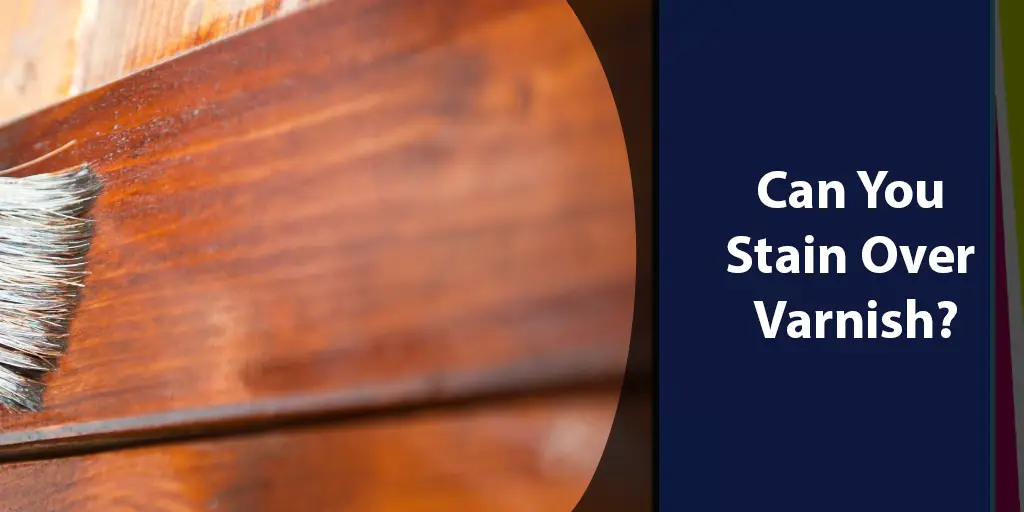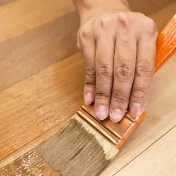Whether you’re sprucing up cabinets in the kitchen or refinishing furniture handed down through generations, staining wood is a go-to method for protecting it and altering its appearance.
But what about when the wood is already covered in varnish? Can you really just stain over that hardened finish, or will you end up with a messy result?

As woodworkers and DIYers tackle more advanced projects, this question comes up more often. While it may seem like a quicker workaround, staining over varnish isn’t always the best path forward.
There are important considerations around the chemical properties of stains and varnishes, as well as the absorption process and longevity of the new finish.
In this comprehensive guide, we’ll explore the ins and outs of varnishes and stains, how they interact, and when staining over varnish may or may not make sense.
We’ll define key terms, examine the wood finishing process step-by-step, analyze common problems that arise, and recommend safer alternatives. Our goal is to arm you with the knowledge to make an informed decision for your specific project needs.
For those simply curious about the intricacies of wood finishing or refining existing skills, we break down the science in an easy-to-digest manner.
Veterans may appreciate the deep dive. Either way, by the end you’ll understand this often debated topic thoroughly enough to confidently tackle your next furniture flippin’ project with a durable, high-quality result.
Let’s get started on our exploration. We’ll cover staining, varnishing, their fundamental differences, and the factors that determine whether staining something that’s already varnished can even be feasible.
Demystifying Stains and Varnishes
When it comes to wood finishes, stains and varnishes are two of the most commonly used products. But what’s the difference between them, and how do they work their magic? Let’s break it down.
Stains are coloring agents designed to alter the wood’s hue without necessarily providing much protection. They work by soaking into the grain to dye the surface. Different stains impart unique shades depending on the pigments, from deep cherry reds to subtle greys.
Most are oil-based for maximum absorption. But water-based stains have grown in popularity due to their lower toxicity. No matter the formulation, stains leave the wood porous, so a topcoat is needed to prevent dirt and damage.
Varnishes, on the other hand, act as a protective sealing coat rather than just a dye. They form a clear, polymeric film over the wood through an evaporative hardening process. This shields the surface from water, abrasions, and UV light rays.
While varnishes don’t change the color themselves, they can enhance the wood’s natural tones or a stained appearance.
Varieties include polyurethane, acrylic and natural resins like shellac. Oil-based polyurethane offers excellent durability for high-traffic areas.
Now you may be thinking – can’t you just stain, then varnish to get both coloring and protection? Not always, as fascinating chemical reactions come into play. The varnish essentially functions as a barrier once dry. This prevents the stain from properly absorbing.
Under the microscope, their distinguishing characteristics become clear. An understanding of these differences, and how they interact, is key to achieving your desired finished look. Read on for more insights on the wood finishing process.
Cracking the Code of the Wood Finishing Process
Now that we’ve broken down the key players in wood finishing, it’s time to examine the step-by-step process. Understanding best practices will ensure your projects have lasting appeal and protection.
The journey begins with evaluating the wood’s characteristics. Factors like grain density, texture, and porosity impact how it will accept and hold any finishes. Softwoods absorb more readily than hardwoods, for example.
Knowing the wood guides stain selection – will it showcase intricate patterns or produce an even tone? Conditioning with sandpaper ensures optimal adhesion, too. A final wipe removes dust so the first coat bonds perfectly.
Next is staining. Oil-based varieties demand longer between applications versus water-based for full saturation. Cotton cloths and lack of lingering puddles point to completeness.
Some techniques, like ragging, work the stain deep for rich color. Others, like wiping, result in lighter, more natural shades perfect for certain eras. Drying times vary significantly.
Once dry, it’s time for a protective topcoat. Varnishes level the surface via brush or sprayer. Polyurethane then hardens as it interacts with air through evaporation and a chemical cross-linking reaction.
Multiple ultra-thin “quick coats” allow for adjustments rather than one thick layer. Light sanding between adds sheen while removing imperfections.
Cracking the Code on Why Staining Over Varnish Often Falls Short
By now, you have a solid grasp of stains, varnishes, and how they work. But the million dollar question remains – can you really stain something that’s already sealed with a clear coat? As it turns out, the science doesn’t necessarily support this approach.
Let’s explore three main reasons why staining over varnish frequently leads to disappointment.
First, there is the barrier created by the finish itself. Once dry, varnish forms an impermeable shield over the wood fibers. This prevents the stain from penetrating below the surface where it needs to bond.
Instead, much of the pigment sits on top and ends up wiped or worn away over time. The color is transient rather than soaking in. Harsh conditions or repeated cleanings can strip it away completely.
Second is the issue of incompatibility between the stain and varnish media. Where an oil-based polyurethane finish may mesh nicely with an oil-based stain during initial application, these polymers do not continue to bond as the piece is used.
Microscopic separation occurs. Over the long run, this causes staining to fade unevenly or in undesirable patches. Consistency suffers.
Lastly, the expected visual effects are often not what transpires. Staining dark over light-colored varnish may yield a solid, flat appearance rather than showcase the grain. Likewise, subtle nuances intended get lost.
In the end, for true longevity, the varnish needs stripped to allow the stain to fully infuse the wood fibers below. Only then will colors stay rich and true for years of enjoyment.
So while staining a varnished surface may seem simple, the underlying science suggests more permanent results demand a different process. Read on for safer, surer alternatives.
Stripping the Varnish: A Necessary Step for Long-Lasting Color
As we’ve learned, stripping away existing varnish is key to allow stain to fully penetrate the grain. The process may seem tedious, but ensures vibrancy for seasons to come.
Chemical strippers soften polyurethane for gentle scraping with a putty knife. Safer natural options utilize organic solvents like citrus-based d-Limonene. Elbow grease with bristle brushes or steel wool quickens the task.
Sanding represents the most labor-intensive path. Start with coarse grit to grind through the varnish, progressing finer until smooth. A random orbital sander speeds the job.
Pro tips: protect plantlife from fumes, wear proper ventilation, and test small areas first. Discard old rags as they can combust. When bare wood appears, rinse and dry thoroughly before staining.
Gel Stains: A Viable Alternative for Varnished Surfaces
Gel-based stains offer a viable workaround for varnished wood without stripping. Their goopy texture allows “flooding” onto verticals and penetration into sealed pores.
Key benefits include diminished dust from rubbing solvents into the grain. Cleanup involves simply washing brushes. Gel also dries faster than liquids.
Consistency comes with practice. Too thin a coat risks streaking as it levels out. Too thick may hinder desired depth effects. Best for even-toning hardwood boards.
Ultimately gel won’t bond as intimately to varnish’s barrier as traditional stains. But they provide splendor when time is limited over complete stripping.
Paint: A Fresh Coat Conceals While Protecting
When appearance alterations outweigh preservation, latex paint deportes varnished surfaces. Low VOC options safeguard indoor air while coming in every color imaginable.
Textured finishes impart warmth through faux finishes. High-quality semi gloss stands up to scuffs and spots. Outdoor lacquers shield from sun and precipitation.
Ensuring Your Wood Finish Stands the Test of Time
By now, you’ve chosen how to approach your project – whether stripping and restaining, trying gel stain, or going in a whole new direction with paint. Whichever route you take, maintenance plays a key role in extending its lifespan.
For stained surfaces, periodically wipe away dirt and grease using a mild cleaner. Too frequent scrubbing can prematurely deteriorate the protective topcoat. Natural oils also nourish the wood over the long haul.
Reapply fresh polyurethane coats every few years for high-traffic pieces like tables. Annual inspections identify areas needing touch-ups before issues arise. Sanding lightly between layers maximizes adhesion.
If staining directly over old varnish, expect to redo colors more regularly as they inevitably fade unevenly. Monitor for signs and retouch promptly. Some areas may need stripping after a few years.
Paint demands even less upkeep – occasional washing is usually sufficient. But natural wear inevitable demands touching up or a whole repaint down the line. Proper preparation prolongs each cycle.
By caring for your hard work, you ensure furnishings maintain their sophisticated charm for housewarmings to come. Future owners will appreciate the TLC too when inherited decades later!
With conscientious maintenance of whichever refinishing approach you take, your wood creations can stand test of time in beauty and protection. Such pieces become family heirlooms.
In Closing: Empowering You with Knowledge to Succeed
We’ve come to the end of our deep dive into the complex world of wood finishes. Whether you’re a seasoned craftsperson or just developing your skills, this comprehensive guide aimed to equip you with valuable insights.
By defining stains and varnishes, exploring their innate properties, examining best practices, analyzing common pitfalls, and offering safer alternatives, our goal was to dissolve uncertainty around this oft-debated topic.
Does staining over varnish make sense in some scenarios? Conditionally, yes – namely with gel stains applied properly or for temporary fixes. But for true long-lasting effect, science affirms stripping the existing sealer first allows stain to fully integrate.
Going forward, consider these takeaways. Evaluate each project and material individually rather than assume one-size-fits-all solutions. Continuous learning optimizes results as techniques evolve.
Resources exist to answer additional questions as they arise. Community expertise also awaits through local woodworking groups.
With the knowledge attained here, feel empowered to complete refinishing transformations that would make even Norman Inn proud. Protect beautiful heirlooms for future generations, too.



